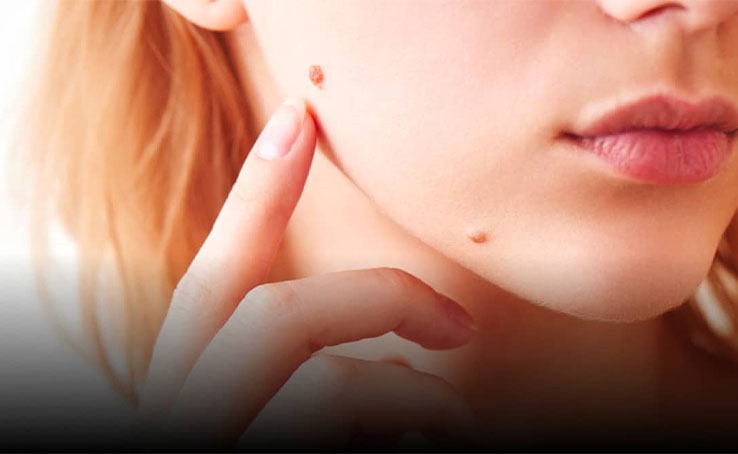Avg Price: $ 62-$ 180


Treatment Time
Recovery Time
Hospitalization Days
Success Rate
The occurrence of moles, also known as nevi, is relatively common. Moles can occur in people of all ages and ethnic backgrounds. Common moles are present in the majority of the U.S. population, with approximately 332 million Americans exhibiting them. The majority of adults typically possess between 10 and 40 common moles. While these moles can be present from birth, they often emerge during childhood. Many individuals continue to form new moles until around the age of 40. As people grow older, common moles tend to diminish.
Nevertheless, most individuals are not satisfied with the presence of these moles from an aesthetic perspective. The desire to look more attractive has always remained as an undeniable need in every society. In contemporary times, medical advancements enable people to achieve a mole-free appearance through procedures like Mole Removal Surgery.
People primarily choose Mole Removal Surgery to enhance their appearance. This emphasizes the vital importance of surpassing individuals' aesthetic expectations, underscoring the requirement for proficient and adequately equipped plastic surgeons to conduct this operation.
In India, plastic surgeons are often recognized as some of the best in performing such procedures, thanks to their exceptional skills and access to advanced medical facilities. Additionally, India boasts cutting-edge medical centers and state-of-the-art surgical equipment, further augmenting surgeons' abilities to deliver safe and precise results. This combination of highly qualified medical professionals and advanced healthcare infrastructure establishes India as a premier destination for individuals seeking cosmetic procedures, including mole removal surgery. Therefore, people worldwide have excellent chances to access these services from the best doctors for mole removal surgery and best hospitals for mole removal surgery in India.
During a Mole Removal procedure, a Dermatologist, a specialized medical doctor focused on diagnosing and treating skin conditions, will either shave or make an incision to eliminate the mole from your skin. This is typically a swift outpatient procedure, enabling your healthcare provider to examine the mole for signs of skin cancer. In certain cases, individuals also opt to remove moles for cosmetic purposes.
Why is Mole Removal Surgery needed?
Mole Removal can address unusual moles located on your Face, Neck, Arms, Legs, or Torso. Your healthcare provider might suggest removing an unusual mole to conduct a biopsy, determining whether it is cancerous (malignant) or precancerous. Additionally, if your dermatologist successfully removes the mole with adequate margins (the surrounding area), mole removal can potentially act as a curative treatment for localized skin cancer. Moreover, if you are dissatisfied with the moles placement or appearance, your healthcare provider may also consider removing it.
Take Charge of Your Health
Book a Free Consultation

There are two primary approaches to mole removal: surgical excision and shave excision. Both methods have their own set of advantages and disadvantages, and its important to consult with your Dermatologist to determine which one is suitable for you.
Surgical Excision: Surgical excision is a commonly used technique for mole removal. After numbing and cleaning the area, your surgeon uses a scalpel to carefully detach the mole from your skin. Depending on the mole's type, they may remove a small portion of healthy skin around it to ensure complete removal of any abnormal cells. The mole is then lifted away using forceps. Some bleeding is normal, and your surgeon may apply pressure or use cauterization to stop the bleeding before closing the area with stitches.
Shave Excision: Shave excision is another common method for mole removal, and it is less invasive than surgical excision. In this procedure, your healthcare provider may shave off the mole's surface instead of making a deep cut. Shave excision can provide a tissue sample for analysis, and most people are satisfied with the results after the healing process. However, it may not be suitable for examining deep tumor margins or differentiating between various types of skin cancer.
For shave excision, your healthcare provider employs a single or double-bladed razor to gently remove the mole until it's flush with the surrounding skin. They may also use cauterization to enhance the appearance of any scars that may form after healing. Moles removed through shave excision have a slightly higher chance of recurrence compared to those removed through surgical excision.
Other Methods of Mole Removal: While some healthcare providers have used methods like lasers, electric current (cautery), or liquid nitrogen (cryotherapy) in the past, these techniques are generally not recommended. These approaches do not provide a mole sample for analysis, making it difficult to identify the type of mole. Additionally, moles removed using these methods are more likely to return (recur). In some cases, benign moles that come back after non-surgical removal can exhibit characteristics of skin cancer.
Prior to a mole removal procedure, your healthcare provider examines your skin and may capture photographs of your moles for future reference. They might also employ a device called a dermoscope to closely examine the mole and decide on the most suitable removal method.
Your healthcare provider will identify and mark the specific areas on your skin that require removal. Subsequently, they will clean the designated area. To ensure your comfort during the procedure, you will receive numbing medication, which can be administered topically on your skin or through an injection at the surgical site. In some cases, you may receive both topical and injectable anesthesia for adequate pain relief.
Your Health is Our Priority
Book a Free Consultation
The steps involved in mole removal surgery can vary depending on the specific method used, the location of the mole, and whether there are concerns about skin cancer. Here are the general steps for Mole Removal Surgery:
1. Anesthesia: Before the mole removal procedure, the area around the mole will be cleaned, and a local anesthetic will be administered to numb the area. This ensures that you won't feel pain during the procedure.
2. Mole Removal: The Dermatologist will use one of the following methods to remove the mole, depending on the type of mole and its location:
3. Hemostasis: After the mole is removed, any bleeding is stopped, typically with gentle pressure or cauterization if necessary.
4. Dressing: A sterile dressing or adhesive strips may be applied to the wound to protect it and aid in healing.
When a Mole is removed by your Dermatologist during an office visit, it is generally considered a procedure with low associated risks. However, as with any medical procedure, there are potential risks involved. These risks encompass:

Following the removal of your mole, your healthcare provider will apply petroleum jelly to the treated area and then cover it with a bandage. It is advisable to maintain the areas moisture by applying the jelly for several days and ensure daily cleaning. Your dermatologist will provide you with instructions on how to care for the wound as it heals. This may include keeping it clean and dry, applying ointment, and avoiding activities that could disrupt the healing process.
Avail the Expert Health Advice
Book a Free Consultation
The majority of Mole Removal Surgeries are brief outpatient operations. You should be capable of driving yourself home following the procedure and resuming work or school right away. Most moles removed by dermatologists are permanently removed. But some moles come back (recur). If you have a mole removed and it comes back after healing, contact your healthcare provider. The majority of treated areas typically undergo full healing in under a month, but in the case of a larger or deeper incision, the healing process may extend to 4-6 weeks.
Depending on the method used for mole removal (excision, shaving, or others), there may be a scar left behind. The appearance of the scar can vary based on factors such as the mole's size, location, and your individual healing process. In some cases, scars may fade significantly over time or be hardly noticeable, while in other cases, they may be more noticeable. The cosmetic results can vary from person to person and depend on factors such as skin type, the skill of the surgeon, and the moles characteristics. Some people may be very satisfied with the cosmetic outcome, while others may have concerns about the appearance of the area after healing.
After Mole Removal, it's important to protect the treated area from excessive sun exposure to minimize the risk of pigmentation changes and to prevent new moles from forming due to sun damage.
Removing a Mole is a straightforward and low-risk procedure, but one potential drawback is the possibility of a small scar being left behind, which is often considered the primary downside of mole removal. Nevertheless, the scar from a biopsy is typically deemed a reasonable trade-off for the peace of mind as it brings in confirming whether an unusual mole is cancerous or not.
The cost of Mole Removal Surgery in India is generally more affordable than in numerous Western nations, while still maintaining world-class quality. The typical price range for under-eye fillers in India spans from $125 to $400.
| Location | Minimum Cost ($) | Average Cost ($) | Maximum Cost ($) |
| Delhi | $ 65 | $ 115 | $ 170 |
| Mumbai | $ 70 | $ 120 | $ 180 |
| Chennai | $ 62 | $ 105 | $ 155 |
| Hyderabad | $ 60 | $ 100 | $ 150 |
Following are the factors affecting cost of Mole Removal Surgery in India:
The expenses for diagnostic tests and evaluations linked to mole removal surgery can fluctuate due to several factors. These factors encompass the particular tests needed, your choice of healthcare facility or clinic, and your geographical location. These diagnostic evaluations may encompass pre-operative assessments, allergy tests, blood tests, urine tests, and other evaluations aimed at confirming your suitability for the procedure and facilitating effective procedure planning. The approximate cost of diagnostics for mole removal surgery treatment is INR 500-1000.
MedFlick, your trusted healthcare companion, is dedicated to ensuring that your medical journey goes as smoothly and successfully as possible.
Fostering expertise backed by commitment, resilience and years of experience, we connect you to a wide network of India's best doctors
Explore the most advanced, reputable and trusted hospitals in India, offering the highest levels of clinical and surgical excellence

The worlds most trusted personalized health community with more than 1,00, 000 members that share their journey, experiences and health insights. Join your community and get access to make informed health decisions.
Explore



